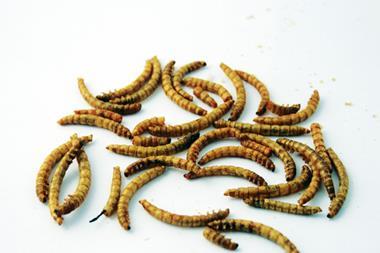With the global population exploding, we should think seriously about swapping our egg sarnies for ant egg sarnies, says a leading food futurologist
Each year, at Christmas, my uncle used to buy a wheel of aged Stilton, fill the centre with port and proceed to eat the entire thing. However, it reached perfection when he could see the maggots crawling out of it. He ate those too.
He’s not the only one who likes foods that would turn many a British stomach. The French enjoy snails the Japanese love the scavenging eel the Chinese delight in the sea cucumber (big sea slug) and Thais are quite partial to a locust kebab. Actually, the British like prawn cocktails - and prawns are basically locusts of the sea. But few think of prawns that way and the prospect of British consumers going a step further and embracing a diet that includes insects as part of its protein source seems slim to say the least.
Yet soon, they will be doing just that - and they won’t just be eating the faddy scorpion lollipops and chocolate-covered ants you find in speciality food stores.
Insect eating has been common in Asia, South America and Africa for millennia: 80% of the world happily consumes about 1,400 insect species on a daily basis. Although it is likely to be some time before Brits happily emulate them - or The Grocer’s features editor, Rob Brown, who sampled some of the delights currently on the market - make no mistake: they will soon be eating more insects - albeit initially in the form of a discreet ingredient in meat sauces, nut replacements and burgers or sausages.
Already, in the UK, it is estimated that each person unwittingly ingests 500g of insect particles a year in jams and processed foods. In the US, the FDA booklet, Food Defect Action Levels, outlines just how many ‘natural common contaminants’ are allowed in processed foods. For example: fruit juices permit one or more maggots per 250ml and peanut butter permits 30 or more insect fragments per 100g.
These are manufacturing aberrations. But ‘mini-livestock’ (insects) are increasingly becoming more popular in their own right. A policy paper on the eating of insects has been put to the UN Food and Agriculture Organization for consideration and there are plans for a world congress on entomology in 2013 - the FAO is also overseeing a locust farming project in Thailand.
In Europe, the Netherlands is leading the charge. Wageningen University started promoting insects as food in the 1990s. Between 2008 and 2009, sales of edible insects in the Netherlands tripled to 900kg, and it continues to rise. Building on this growth, the Dutch ministry of agriculture is funding a new £1m research programme to develop ways to raise edible insects on the by-product of beer brewing and apple juice pressing. Other research is focusing on how protein could be extracted from insects to create alternative edibles.
The reasons for such heavyweight endorsements are manyfold. Raising insects is environmentally friendly. They require minimal space per pound of protein produced, have a better feed-to-meat ratio than any other animal, more of their body mass is edible and they are very low in the food chain. They reproduce quickly and without any added hormones and they are good for you, with statistics showing they have high protein and calcium densities.
They’re also incredibly versatile. Toasted, fried, roasted and chocolate-covered are among the most popular ways of eating insects at the moment, but it seems to me that insect burgers are just a few years away, although their success is likely to depend heavily on how cleverly they are marketed.
A marketing campaign extolling the virtues of insect eating will no doubt help to grow consumption. Demand may also be driven by the rising cost of meat as fuel prices increase, and by consumer concern as animal feed is compromised and competitive factors reduce the quality of livestock living conditions. Such factors have already worked wonders for foodstuffs once considered unsavoury. What was once poor man’s food (offal, tongue, brains) has become a delicacy a theme and trend moving from high-end restaurants in the past few years and into the mainstream as a clever way to bridge the cost of prime cuts of meat.
Growing producer transparency, consumer awareness, free publishing on proliferating digital platforms, health concerns and accessibility of information online will all contribute to sales of free-range and non-GM meats. The consumer’s ability to scan barcodes on packs to trace the exact stock and farm the food came from will only increase the demand for provenance and change the value of meat as an everyday commodity.
‘GM-free’ is already the fastest-growing grocery label in the US, attesting to the shift in consumer interest from mass-produced, potentially unethical sources of protein, to smaller quantities of carefully reared meat. This can only boost the prospects of insects being regarded as a serious alternative source of protein in the future - and not just in cheap staple foods.
Marc Dennis, a Brooklyn entomologist, has been hosting insect-based dinner parties for the past few years and hopes to make cricket flour and create a new line in insect snacks. “One of my goals is to create protein bars: Hoppin’ Good bars, with crickets, oats, grains and nuts - triple the protein with zero fat content,” he says.
A number of entomologists have published books and recipes extolling the virtues of the mini-livestock. As far back as 1885, as Mrs Beeton, Good Housekeeping and other Victorian culinary treasures took hold, British entomologist Vincent M Holt published a small book called Why Not Eat Insects. He wrote: “Is it not a wonder that people do not look around them for the many gastronomic treasures lying neglected at their feet? Prejudice, prejudice, thy strength is enormous!
One hundred and fifty years later, isn’t it high time we changed our tune?


















1 Readers' comment